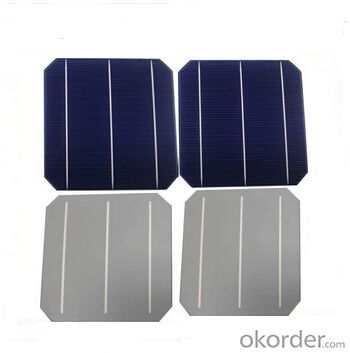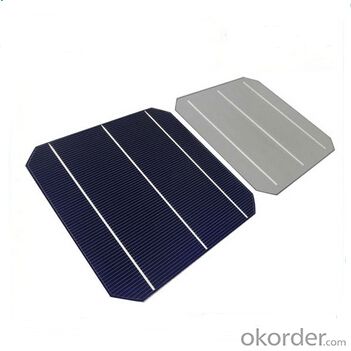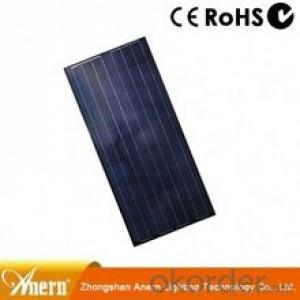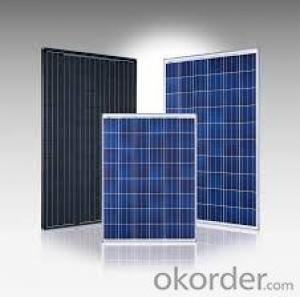Monocrystalline Solar Cells High Quality 16.40-17.60
- Loading Port:
- Shanghai
- Payment Terms:
- TT OR LC
- Min Order Qty:
- 1000 pc
- Supply Capability:
- 1000000 pc/month
OKorder Service Pledge
OKorder Financial Service
You Might Also Like
Solar Cells:
Solar cells is made by solar wafer, it has three categories of solar cell right now, monocrystalline polycrystalline and thin film,These cells are entirely based around the concept PN junction, which is the critical part of solar module, it is the part that can convert the light energy into electricity, the thickness is from 180um to 200um, with even busbars to conduct electricity, textured cell can decrease diffuse reflection; they are often electrically connected and encapsulated as a module. Photovoltaic modules often have a sheet of glass on the front (sun up) side, allowing light to pass while protecting semiconductor wafers from abrasion and impact due to wind-driven debris, rain, hail, etc. Solar cells are also usually connected in series in modules, creating an additive voltage. Connecting cells in parallel will yield a higher current;With high quality and stable quality. Our Cells can greatly improve the performance of Solar Modules.
Features:
1. High conversion efficiencies resulting in superior power output performance.
2. Outstanding power output even in low light or high temperature conditions
3. Optimized design for ease of soldering and lamination
4. Long-term stability, reliability and performance
5. Low breakage rate
6. Color uniformity
Solar Cells Advantage:
• High efficiency and stable performance in photovoltaic conversion.
• Advanced diffusion technique ensuring the homogeneity of energy conversion efficiency of the cell.
• Advanced PECVD film forming, providing a dark blue silicon nitride anti-reflection film of homogenous color and attractive appearance.
• High quality metal paste for back surface and electrode, ensuring good conductivity, high pulling strength and ease of soldering.
• High precision patterning using screen printing, ensuring accurate busbar location for ease with automatic soldering a laser cutting.
Specifications:
Dimensions | 156x156 mm |
Diagonal | 220 mm |
Cell Thickness | 180/200 ± 20μm |
Front | Blue silicon nitride anti-reflective coatings |
3x1.5mm silver busbar | |
Back | Full-surface aluminum back-surface field |
3x3.0mm (silver/aluminum) discontinuous soldering pads |
Electrical Characteristics | ||||||
Efficiency code | Efficiency Eff(%) | Power Pmax(W) | Max.Power Current Ipm(A) | Short Circuit Current Isc(A) | Max.Power Voltage Vpm(V) | Open Circuit Voltage Voc(V) |
1760 | 17.60 | 4.28 | 8.097 | 8.561 | 0.529 | 0.631 |
1740 | 17.40 | 4.23 | 8.035 | 8.506 | 0.527 | 0.629 |
1720 | 17.20 | 4.19 | 7.973 | 8.454 | 0.525 | 0.627 |
1700 | 17.00 | 4.14 | 7.910 | 8.398 | 0.523 | 0.625 |
1680 | 16.80 | 4.09 | 7.847 | 8.335 | 0.521 | 0.623 |
1660 | 16.60 | 4.04 | 7.769 | 8.267 | 0.520 | 0.622 |
1640 | 16.40 | 3.99 | 7.690 | 8.203 | 0.519 | 0.621 |
Packaging & Delivery of Solar Cells
Carton Box Package and Deliver by air. It should be noticed that it should be avoid of water, sunshine and moist.


FAQ
We have organized several common questions for our clients,may help you sincerely:
①What price for each watt?
It depends on the efficiency of the solar cell, quantity, delivery date and payment terms.
②How long can we receive the product after purchase?
In the purchase of product within three working days, We will arrange the factory delivery as soon as possible. The pecific time of receiving is related to the state and position of customers.Commonly 7 to 10 working days can be served.
③Can you provide the peripheral products of the solar panels, such as the battery, controller, and inverter? If so, can you tell me how do they match each other?
Yes, we can, we have two companies for solar region, one is CNBM International, the other is CNBM engineering Co.
We can provide you not only the solar module but also the off grid solar system, we can also provide you service with on grid plant.
④What is your warranty of solar cell?
Our product can promise lower than 0.3% open box crack, we support claim after opening the box if it has crackm color difference or sth, the buyer should give pictures immediately, we can not accept the claim after the solar cell has assembled to solar panel.
• Timeliness of delivery
• ⑤How do you pack your products?
We have rich experience on how to pack the solar cell to make sure the safety on shipment, we could use wooden box or pallet as buyer's preference.
- Q:What is the future of solar cell technology?
- The future of solar cell technology holds great potential for advancements in efficiency, affordability, and integration into various applications. Researchers are constantly exploring new materials, such as perovskites and organic polymers, to overcome the limitations of traditional silicon-based solar cells. Innovations like tandem solar cells and multi-junction solar cells are expected to significantly increase conversion efficiency. Additionally, advancements in manufacturing techniques, such as printing and roll-to-roll processes, aim to reduce production costs and facilitate large-scale deployment. Integration of solar cells into everyday objects, like windows, clothing, and electronic devices, is also an exciting prospect. Overall, the future of solar cell technology seems promising and will play a crucial role in transitioning towards a more sustainable and renewable energy future.
- Q:How do solar cells contribute to reducing greenhouse gas emissions?
- Solar cells contribute to reducing greenhouse gas emissions by converting sunlight into electricity without the need for burning fossil fuels. As solar cells generate clean and renewable energy, they help to offset the use of fossil fuel-based power plants that release harmful greenhouse gases into the atmosphere. By utilizing solar energy, we can decrease our reliance on carbon-intensive energy sources, thus mitigating climate change and reducing greenhouse gas emissions.
- Q:Can solar cells be used in theme parks?
- Yes, solar cells can be used in theme parks. Solar cells can be installed on rooftops, parking lots, or open spaces within theme parks to generate clean and renewable energy. This energy can be used to power rides, lighting, and other facilities, reducing the park's dependence on traditional energy sources and lowering its carbon footprint. Additionally, solar cells can also serve as educational tools, allowing visitors to learn about renewable energy and sustainability.
- Q:Can solar cells be used for powering electric vehicles charging stations?
- Yes, solar cells can be used to power electric vehicle charging stations. Solar panels can generate electricity from sunlight, which can be used to charge electric vehicles. This renewable energy source is clean and sustainable, reducing reliance on fossil fuels and decreasing carbon emissions. Additionally, solar-powered charging stations can be installed in remote locations where grid connection may not be feasible.
- Q:Can solar cells be used for powering irrigation systems?
- Yes, solar cells can be used for powering irrigation systems. Solar energy can be converted into electricity through solar cells, which can then be used to power irrigation pumps and other components of the irrigation system. This provides a sustainable and environmentally friendly way to meet the energy needs of irrigation systems, especially in remote areas or regions with limited access to the electricity grid.
- Q:Can solar cells be used for powering medical devices?
- Yes, solar cells can be used for powering medical devices. Solar cells can generate electricity from sunlight, which can then be used to power various types of medical devices such as portable medical monitors, insulin pumps, and even small surgical tools. This offers a sustainable and reliable source of energy, particularly in remote or resource-limited areas where access to electricity may be limited.
- Q:Can solar cells be damaged by hail or other weather events?
- Yes, solar cells can be damaged by hail or other severe weather events. Hailstones can cause physical damage to the surface of the solar panels, leading to cracks or shattered glass. Additionally, strong winds, heavy rain, or extreme temperatures can also impact the performance and durability of solar cells. It is crucial to consider the weather conditions and take necessary precautions during the installation and maintenance of solar panels to minimize potential damage.
- Q:Can solar cells be used for powering military bases?
- Yes, solar cells can definitely be used for powering military bases. Solar energy is a reliable and sustainable source of power that can be harnessed through the use of solar cells. Implementing solar panels on military bases can help reduce dependence on traditional fossil fuel-based energy sources, increase energy security, and provide a more environmentally friendly and cost-effective solution for powering military operations.
- Q:Can solar cells be used in powering remote monitoring systems?
- Yes, solar cells can be used to power remote monitoring systems. Solar cells convert sunlight into electrical energy, which can be stored in batteries or used directly to power electronic devices. This makes them a sustainable and reliable source of power for remote monitoring systems, especially in areas where access to electricity is limited or unreliable. By harnessing solar energy, remote monitoring systems can operate independently and continuously, making them an ideal solution for remote locations.
- Q:How do solar cells perform in high altitude locations?
- Solar cells generally perform better in high altitude locations compared to lower altitude areas. This is because higher altitudes often have less atmospheric interference, such as pollution and cloud cover, which can obstruct sunlight. Additionally, the thinner atmosphere at high altitudes allows for more direct and intense sunlight, resulting in increased solar energy generation. Overall, solar cells in high altitude locations can harness more sunlight and produce higher energy output.
1. Manufacturer Overview |
|
|---|---|
| Location | |
| Year Established | |
| Annual Output Value | |
| Main Markets | |
| Company Certifications | |
2. Manufacturer Certificates |
|
|---|---|
| a) Certification Name | |
| Range | |
| Reference | |
| Validity Period | |
3. Manufacturer Capability |
|
|---|---|
| a)Trade Capacity | |
| Nearest Port | |
| Export Percentage | |
| No.of Employees in Trade Department | |
| Language Spoken: | |
| b)Factory Information | |
| Factory Size: | |
| No. of Production Lines | |
| Contract Manufacturing | |
| Product Price Range | |
Send your message to us
Monocrystalline Solar Cells High Quality 16.40-17.60
- Loading Port:
- Shanghai
- Payment Terms:
- TT OR LC
- Min Order Qty:
- 1000 pc
- Supply Capability:
- 1000000 pc/month
OKorder Service Pledge
OKorder Financial Service
Similar products
New products
Hot products
Hot Searches
Related keywords


























